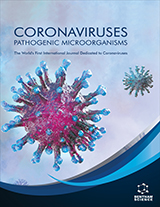Abstract
Background: Alopecia Areata (AA) is a systemic autoimmune condition that usually starts in childhood.
Objective: This article aims to review genetics, therapy, prognosis, and recent patents for AA.
Methods: We used clinical queries and keywords “alopecia areata” AND “childhood” as a search engine. Patents were searched using the key term “alopecia areata” in Patents.google.com and freepatentsonline. com.
Results: Due to an immune-mediated damage to the hair follicles, hair is lost from the scalp and other areas of the body temporarily or even permanently. Children with AA are generally healthy. Evidence of genetic association and increased predisposition for AA was found by studying families with affected members. Pathophysiologically, T- lymphocytes attack hair follicles and cause inflammation and destruction of the hair follicles and hair loss. In mild cases, there would be well-demarcated round patchy scalp hair loss. The pathognomonic “exclamation mark hairs” may be seen at the lesion periphery. In more severe cases, the hair loss may affect the whole scalp and even the whole body. The clinical course is also variable, which may range from transient episodes of recurrent patchy hair loss to an indolent gradually deteriorating severe hair loss. The treatment of AA depends on factors including patients’ age, the extent of the hair loss, duration of disease, psychological impact, availability and side effect profile of the treatments. For localized patchy alopecia, topical application of corticosteroids and/or intralesional corticosteroids are the treatment of choice. Other topical treatments include minoxidil, anthralin, coal tar and immunotherapy. In severe resistant cases, systemic immunosuppressants may be considered. Although herbal medicine, acupuncture, complementary and alternative medicine may be tried on children in some Asian communities, the evidence to support these practices is lacking. To date, only a few recent patents exist in topical treatments, including Il-31, laser and herbal medications. Clinical efficacy is pending for these treatment modalities.
Conclusion: None of the established therapeutic options are curative. However, newer treatment modalities, including excimer laser, interleukin-31 antibodies and biologics, are evolving so that there may be significant advances in treatment in the near future. AA can be psychosocially devastating. It is important to assess the quality of life, degree of anxiety, social phobia and mood of the patients and their families. Psychological support is imperative for those who are adversely affected psychosocially.
Keywords: Alopecia areata, alopecia totalis, alopecia universalis, corticosteroids, interleukin-31, minoxidil, psychological stress.
[http://dx.doi.org/10.1016/S0190-9622(84)80450-8] [PMID: 6210311]
[http://dx.doi.org/10.2174/187221311795399291] [PMID: 21453266]
[http://dx.doi.org/10.1007/s12325-008-0044-8] [PMID: 18463804]
[http://dx.doi.org/10.1016/j.it.2004.09.014] [PMID: 15629407]
[http://dx.doi.org/10.1177/146642409311300509] [PMID: 8230078]
[PMID: 18425901]
[http://dx.doi.org/10.4065/70.7.628] [PMID: 7791384]
[http://dx.doi.org/10.1016/j.autrev.2005.07.001] [PMID: 16338213]
[http://dx.doi.org/10.1016/j.jaad.2009.10.032] [PMID: 20115945]
[http://dx.doi.org/10.1111/j.0736-8046.2004.21203.x] [PMID: 15078347]
[PMID: 18792541]
[http://dx.doi.org/10.1046/j.1525-1470.1999.99002.x] [PMID: 10027990]
[http://dx.doi.org/10.1186/1471-5945-5-11] [PMID: 16259629]
[http://dx.doi.org/10.1016/j.sder.2008.12.002] [PMID: 19341938]
[http://dx.doi.org/10.1111/1523-1747.ep12471869] [PMID: 2022874]
[http://dx.doi.org/10.1001/archderm.1963.01590210048007] [PMID: 14043621]
[http://dx.doi.org/10.1111/j.1365-4362.1992.tb03932.x] [PMID: 1568816]
[PMID: 1361288]
[http://dx.doi.org/10.1086/511442] [PMID: 17236136]
[http://dx.doi.org/10.3928/00904481-20090511-07] [PMID: 19685659]
[http://dx.doi.org/10.1016/j.jaad.2009.10.031] [PMID: 20115946]
[http://dx.doi.org/10.1046/j.1365-4362.2002.01357.x] [PMID: 12452996]
[http://dx.doi.org/10.1007/s12519-019-00230-w]
[http://dx.doi.org/10.2174/1872213X113079990022] [PMID: 23829414]
[http://dx.doi.org/10.1017/S146239940601101X] [PMID: 16787552]
[http://dx.doi.org/10.1016/S0002-9440(10)63151-3] [PMID: 14742267]
[PMID: 7716973]
[http://dx.doi.org/10.1016/S0140-6736(01)06943-4] [PMID: 11747911]
[http://dx.doi.org/10.1111/j.1600-0625.1999.tb00385.x] [PMID: 10536963]
[http://dx.doi.org/10.1097/DAD.0b013e318185a66e] [PMID: 19155726]
[http://dx.doi.org/10.1038/jid.1995.48] [PMID: 7537784]
[http://dx.doi.org/10.1038/jid.2009.111] [PMID: 19434088]
[PMID: 18833068]
[PMID: 2965691]
[http://dx.doi.org/10.1111/j.1365-2133.1969.tb15967.x] [PMID: 5359449]
[http://dx.doi.org/10.1038/nm.3645] [PMID: 25129481]
[PMID: 15358573]
[http://dx.doi.org/10.1016/S0190-9622(08)80226-5] [PMID: 1430401]
[http://dx.doi.org/10.1111/j.1742-4801.2004.00054.x] [PMID: 16722877]
[http://dx.doi.org/10.1136/bmj.1.5951.191] [PMID: 122906]
[http://dx.doi.org/10.1111/j.1365-2133.1981.tb01200.x] [PMID: 7284245]
[http://dx.doi.org/10.1038/nature09114] [PMID: 20596022]
[PMID: 7593774]
[http://dx.doi.org/10.1111/1523-1747.ep12412584] [PMID: 7798612]
[http://dx.doi.org/10.1111/j.1365-2133.2011.10466.x] [PMID: 21692766]
[http://dx.doi.org/10.1016/S0733-8635(05)70394-6] [PMID: 9238326]
[http://dx.doi.org/10.1111/j.1529-8019.2011.01411.x] [PMID: 21689242]
[http://dx.doi.org/10.1111/ced.12556]
[http://dx.doi.org/10.1067/mjd.2000.103909] [PMID: 10727299]
[http://dx.doi.org/10.1159/000287786] [PMID: 6701270]
[http://dx.doi.org/10.1016/S1578-2190(10)70667-3] [PMID: 20525487]
[http://dx.doi.org/10.1016/j.jaad.2006.05.008] [PMID: 16908349]
[http://dx.doi.org/10.1111/j.1365-4362.1996.tb01610.x] [PMID: 8838924]
[http://dx.doi.org/10.1046/j.1365-4362.1999.00004.x] [PMID: 10369536]
[http://dx.doi.org/10.1007/s13555-020-00370-2] [PMID: 32270396]
[http://dx.doi.org/10.1001/jamadermatol.2013.3049]
[http://dx.doi.org/10.1111/j.1468-3083.2006.02106.x] [PMID: 17659001]
[http://dx.doi.org/10.1111/j.1365-4362.1994.tb02921.x] [PMID: 8002158]
[http://dx.doi.org/10.1001/archderm.1992.01680130082010] [PMID: 1550369]
[http://dx.doi.org/10.1038/ncomms6966]
[http://dx.doi.org/10.1097/00004583-199705000-00019] [PMID: 9136503]
[PMID: 1357886]
[http://dx.doi.org/10.1016/0010-440X(91)90045-E] [PMID: 1884604]
[http://dx.doi.org/10.1016/0016-5085(95)90597-9] [PMID: 7557104]
[PMID: 18833045]
[http://dx.doi.org/10.1046/j.1440-1754.2003.00116.x] [PMID: 12603809]
[PMID: 4030012]
[http://dx.doi.org/10.1111/j.1468-3083.1998.tb00727.x] [PMID: 9553924]
[http://dx.doi.org/10.1111/j.1468-3083.2008.02830.x] [PMID: 18540984]
[http://dx.doi.org/10.1111/j.1365-4632.2008.03692.x] [PMID: 18613874]
[http://dx.doi.org/10.1016/j.sder.2006.01.003] [PMID: 16616299]
[http://dx.doi.org/10.1016/j.jaad.2006.12.032] [PMID: 17637364]
[http://dx.doi.org/10.1007/BF01061629] [PMID: 5549963]
[http://dx.doi.org/10.1038/jid.1995.46] [PMID: 7738382]
[http://dx.doi.org/10.1046/j.1524-4725.1999.99045.x] [PMID: 10469109]
[http://dx.doi.org/10.1001/archderm.139.12.1555]
[PMID: 8698680]
[http://dx.doi.org/10.1111/j.1365-4632.2006.02639.x] [PMID: 16700791]
[http://dx.doi.org/10.2165/00148581-200507060-00005] [PMID: 16356024]
[http://dx.doi.org/10.1111/j.1365-4632.2006.02764.x] [PMID: 17040439]
[http://dx.doi.org/10.2174/1872213X14666200106145624] [PMID: 31906842]
[http://dx.doi.org/10.4103/0378-6323.174411] [PMID: 27088942]
[http://dx.doi.org/10.4103/0974-7753.82123]
[http://dx.doi.org/10.1001/archderm.1963.01590150100019] [PMID: 13947877]
[http://dx.doi.org/10.1016/S0190-9622(86)70158-8] [PMID: 3528241]
[http://dx.doi.org/10.1159/000252466] [PMID: 4250339]
[http://dx.doi.org/10.1111/j.1600-0560.1977.tb00889.x] [PMID: 915049]
[http://dx.doi.org/10.1080/08035250600612298] [PMID: 17062476]
[http://dx.doi.org/10.1016/j.jaad.2004.05.019] [PMID: 15627095]
[http://dx.doi.org/10.1001/archderm.1990.01670300056006] [PMID: 2140670]
[http://dx.doi.org/10.1111/1523-1747.ep12471880] [PMID: 2022876]
[http://dx.doi.org/10.1016/S0190-9622(87)70095-4] [PMID: 3549809]
[http://dx.doi.org/10.1001/archderm.1992.01680210045005] [PMID: 1444500]
[http://dx.doi.org/10.1159/000079595] [PMID: 15316165]
[http://dx.doi.org/10.1016/S0190-9622(87)80003-8] [PMID: 3549811]
[http://dx.doi.org/10.1159/000096924] [PMID: 17191059]
[http://dx.doi.org/10.1016/S0733-8635(05)70400-9] [PMID: 9238332]
[http://dx.doi.org/10.1007/s00403-007-0759-4]
[http://dx.doi.org/10.1016/S0190-9622(98)70048-9] [PMID: 9810892]
[http://dx.doi.org/10.1007/BF00416931] [PMID: 6446265]
[http://dx.doi.org/10.1001/jamadermatol.2018.2312] [PMID: 30073292]
[PMID: 11493099]
[http://dx.doi.org/10.1111/j.1365-2133.1991.tb06064.x] [PMID: 1911299]
[http://dx.doi.org/10.1111/j.1365-2133.1996.tb03835.x] [PMID: 8915150]
[http://dx.doi.org/10.1016/S0190-9622(96)90323-0] [PMID: 8708020]
[http://dx.doi.org/10.1111/j.1365-4362.1996.tb03281.x] [PMID: 8850047]
[http://dx.doi.org/10.1001/archderm.1977.01640120099035] [PMID: 596915]
[http://dx.doi.org/10.1046/j.1365-4362.1998.00422.x]
[http://dx.doi.org/10.1046/j.1525-1470.1998.1998015313.x] [PMID: 9720702]
[http://dx.doi.org/10.1016/S0190-9622(98)70009-X] [PMID: 9777767]
[http://dx.doi.org/10.1159/000051642] [PMID: 11385229]
[PMID: 12746668]
[http://dx.doi.org/10.1016/S0190-9622(97)70342-6] [PMID: 8996277]
[PMID: 18154427]
[http://dx.doi.org/10.5021/ad.2015.27.6.676]
[http://dx.doi.org/10.1177/1203475418824079]
[http://dx.doi.org/10.1080/17512433.2020.1702878]
[http://dx.doi.org/10.1001/jamadermatol.2017.0001]
[http://dx.doi.org/10.1016/S0140-6736(18)32987-8]
[http://dx.doi.org/10.1016/j.jaad.2018.08.041] [PMID: 30195571]
[http://dx.doi.org/10.1172/jci.insight.89790]
[http://dx.doi.org/10.1016/j.jdcr.2019.07.005] [PMID: 31681829]
[http://dx.doi.org/10.1001/jamadermatol.2015.4445]
[http://dx.doi.org/10.1016/j.jaad.2005.06.031] [PMID: 16310083]
[http://dx.doi.org/10.1016/j.jaad.2008.08.029] [PMID: 19293023]
[http://dx.doi.org/10.1111/bjd.12397] [PMID: 23607773]
[http://dx.doi.org/10.1016/S0190-9622(85)70088-6] [PMID: 3989026]
[http://dx.doi.org/10.1111/j.1365-2133.1993.tb03309.x] [PMID: 8369209]
[http://dx.doi.org/10.1111/j.1365-2133.1995.tb06925.x] [PMID: 8547044]
[http://dx.doi.org/10.1111/j.1525-1470.2009.00980.x] [PMID: 19840308]
[http://dx.doi.org/10.1159/000051360]
[PMID: 15053403]
[http://dx.doi.org/10.2147/CCID.S22767] [PMID: 21833161]
[http://dx.doi.org/10.1111/j.1365-2133.1987.tb04937.x] [PMID: 3314975]
[http://dx.doi.org/10.1016/S1085-5629(05)80033-1] [PMID: 7742246]
[http://dx.doi.org/10.1111/j.1365-2230.1989.tb02604.x] [PMID: 2605805]
[http://dx.doi.org/10.1071/HE07098] [PMID: 17663656]
[http://dx.doi.org/10.1016/S0190-9622(03)02141-8] [PMID: 14639378]
[http://dx.doi.org/10.1046/j.1523-1747.2003.12059.x] [PMID: 12603852]
[http://dx.doi.org/10.1111/j.0906-6705.2004.00098.x] [PMID: 15009110]
[http://dx.doi.org/10.1046/j.1087-0024.2003.00812.x]
[http://dx.doi.org/10.2165/11530040-000000000-00000] [PMID: 20000871]
[http://dx.doi.org/10.1080/00015550252948077] [PMID: 12125957]
[http://dx.doi.org/10.1038/ni1084] [PMID: 15184896]
 133
133 1
1


















